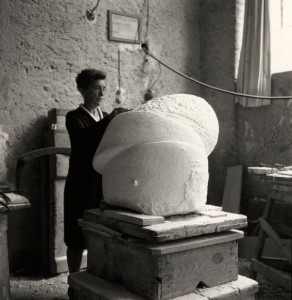Analyze This
Clues abound as to the auto-biographical nature of Louise Bourgeois’s art, with her menacing spider sculptures called “Maman” (French for “mom”) and sexually charged installations like The

Louise Bourgeois sculpting Sleep II in Italy, 1967 (above). The Dangerous Obsession, 2003 (below). STUDIO FOTOGRAFICO, CARRARA/©THE EASTON FOUNDATION
Destruction of the Father. But few beyond her inner circle know that the late artist underwent Freudian analysis for three decades, using it to decipher the childhood traumas and fantasies that recur relentlessly throughout her work.
Appropriately, the Freud Museum, located inside the former London home of the father of psychoanalysis, is showing a selection of recently discovered writings that Bourgeois made while in therapy, together with key artworks. Titled “Louise Bourgeois: The Return of the Repressed,” the exhibition runs through May 27.
“Art was for Louise a system of self-knowledge . . . of discharging tensions and anxieties, of exorcising early traumas,” says Philip Larratt-Smith, Bourgeois’s literary archivist and the curator of the show, a version of which toured Latin America last year. Bourgeois was born into an affluent French family and moved to New York City in 1938, when she married the American art historian Robert Goldwater, living mainly in Chelsea until her death in 2010, at age 98. Severely depressed after her father died, she entered therapy in 1951 and from 1952 to 1982 saw Henry Lowenfeld, a disciple of Freud.
Much of Bourgeois’s emotional distress centered on an obsession with her volatile father, a serial philanderer who had an affair with the girl’s English governess. But her relationship with her forgiving mother was no less conflicted—in a 1958 document, Bourgeois recorded a dream of “the poisoning mother . . . the witch that wants to kill you.”
Suicidal impulses, murderous threats, and feelings of rage, jealousy, guilt, and desire spill out of the writings, which were unearthed by Bourgeois’s assistant, Jerry Gorovoy, in two caches, in 2004 and 2010. Laid out in spirals or stacked columns, these notes often resemble the forms of her sculptures.
Between 1953 and 1964, while in intensive therapy, Bourgeois stopped exhibiting art. “Her psychoanalytic writing plugs this gap in our knowledge,” says Larratt-Smith. “It sketches in the importance of psychoanalysis in the development of her work as a whole, not just in the 1950s but all the way to the end in 2010.” Upon her reemergence in the art world, Bourgeois stopped making her previous series of rectilinear monoliths, called “Personnages,” and started to craft soft shapes resembling body parts.
Prominent works in the Freud Museum exhibition include Janus Fleuri (1968)—a bronze hanging sculpture that evokes a double-headed phallus—and the embroidered text piece I Am Afraid (2009), which conveys the anguish found in her therapy notes in its final two lines: “Empty stomach empty house empty bottle/The falling into a vacuum signals the abandonment of the mother.”
By Elizabeth Fullerton
Source: http://www.artnews.com